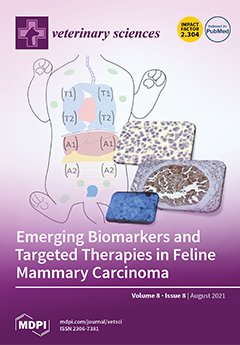Although chloramphenicol is currently banned from use in livestock, other phenicols, such as florfenicol and thiamphenicol, have been used for the treatment of bacterial infections in domestic cattle in Korea. This study compares the characteristics of chloramphenicol-resistant
Enterococcus faecalis isolated from the bulk
[...] Read more.
Although chloramphenicol is currently banned from use in livestock, other phenicols, such as florfenicol and thiamphenicol, have been used for the treatment of bacterial infections in domestic cattle in Korea. This study compares the characteristics of chloramphenicol-resistant
Enterococcus faecalis isolated from the bulk tank milk of four major dairy companies in Korea. Although the distribution of multidrug resistance patterns showed no significant differences between the four companies, 85 chloramphenicol-resistant
Enterococcus faecalis isolates showed a significantly high number of resistances against five or six antimicrobial classes (37.6%, respectively) (
p < 0.05). When analyzing the distribution of phenicol resistance genes, 31 (36.5%) isolates only carried the
catA gene, and two (6.3%) isolates from company A only carried the
cfr gene. No isolates carried the
catB or
fexA genes. Regarding the distribution of other resistance genes, both the
tetL and
tetM (45.9%),
ermB (82.4%), and both
aac(6″)-Ie-aph(2″)-la and
ant(6′)-Ia genes (30.6%) showed a high prevalence, and the
optrA and
poxtA genes were observed separately, each in only two (2.4%) isolates. Our results confirm that the dissemination of chloramphenicol-resistant
Enterococcus faecalis and some antimicrobial resistance genes show significant differences between dairy companies. Therefore, our results support that each dairy company should undertake effective surveillance programs to better understand and minimize the emergence of resistance on a multidisciplinary level.
Full article






